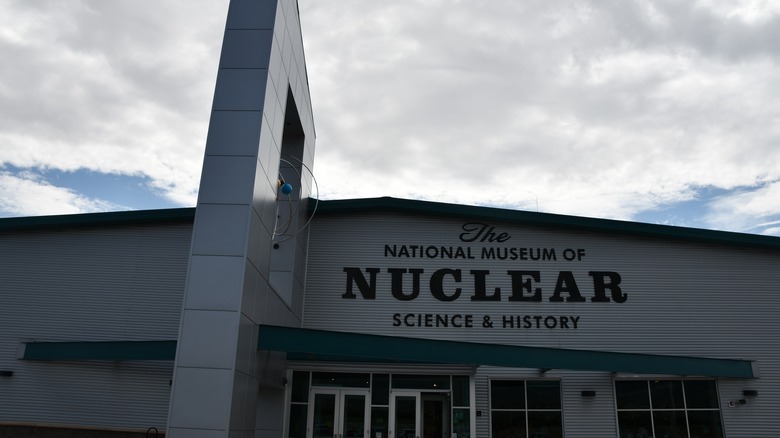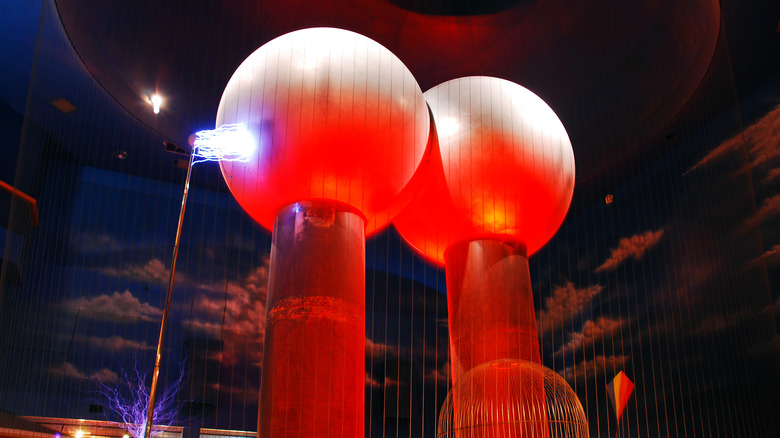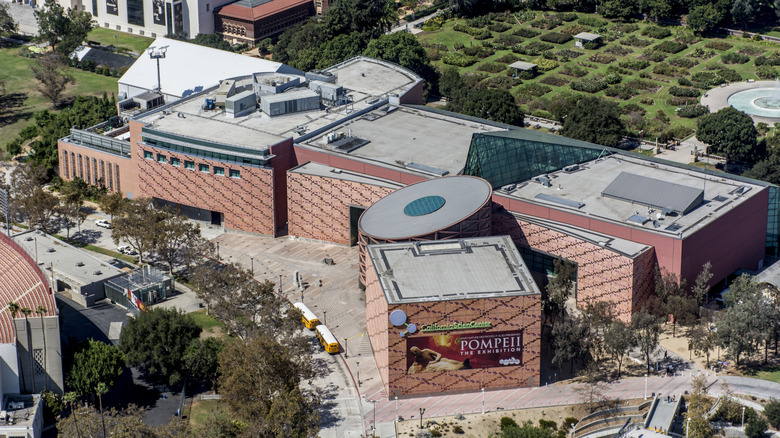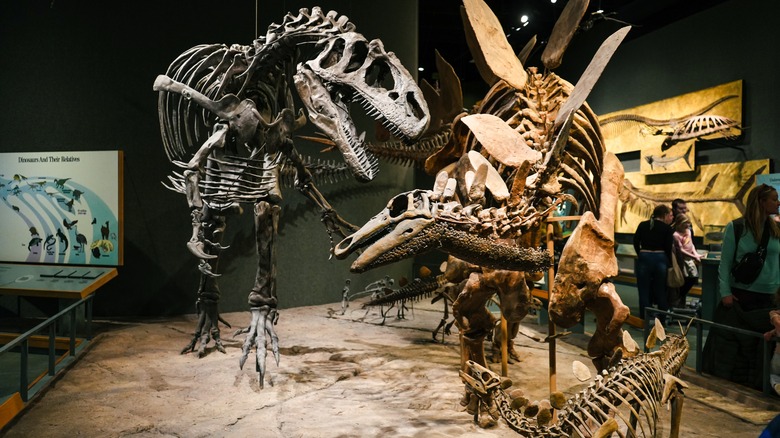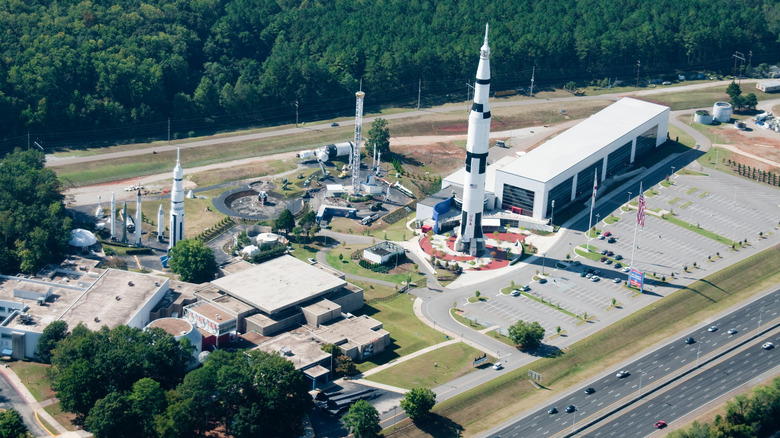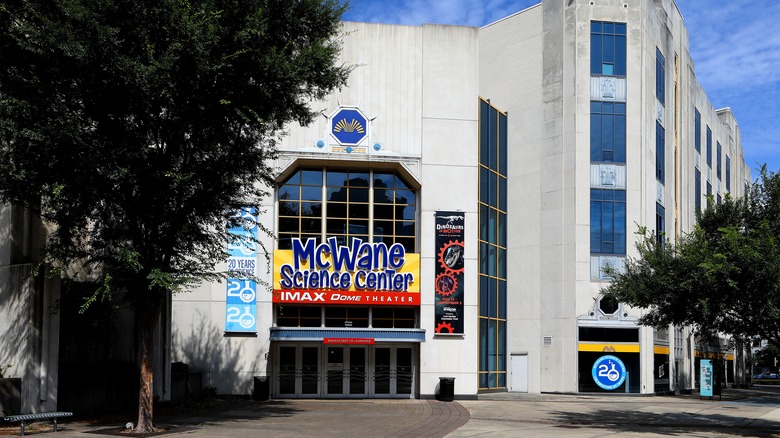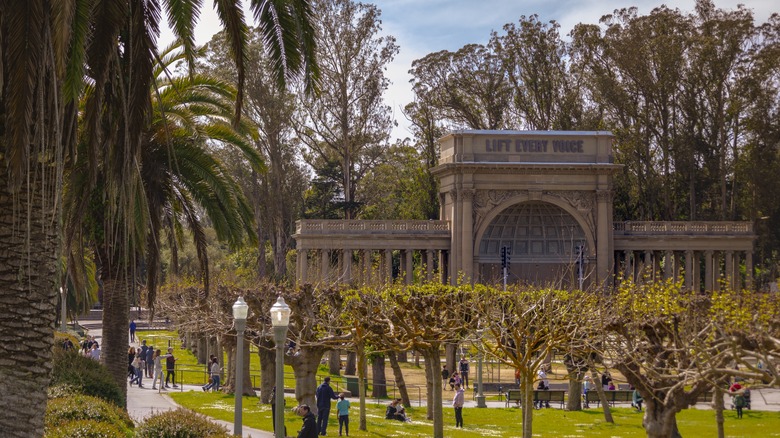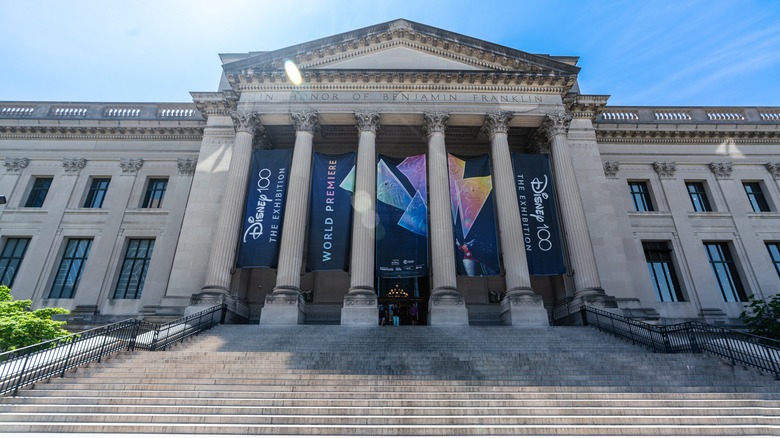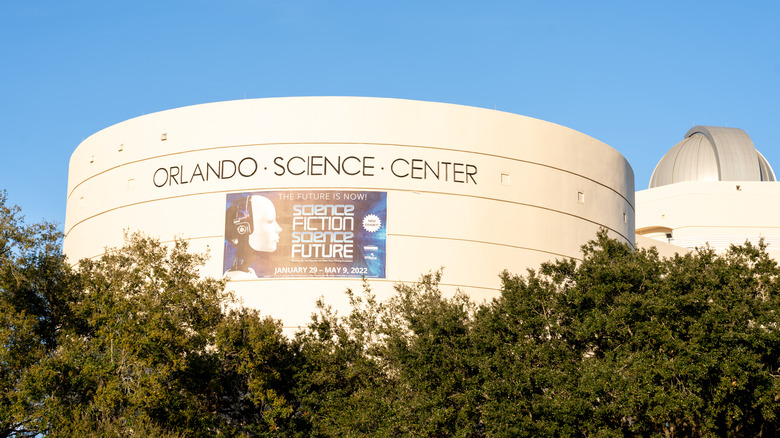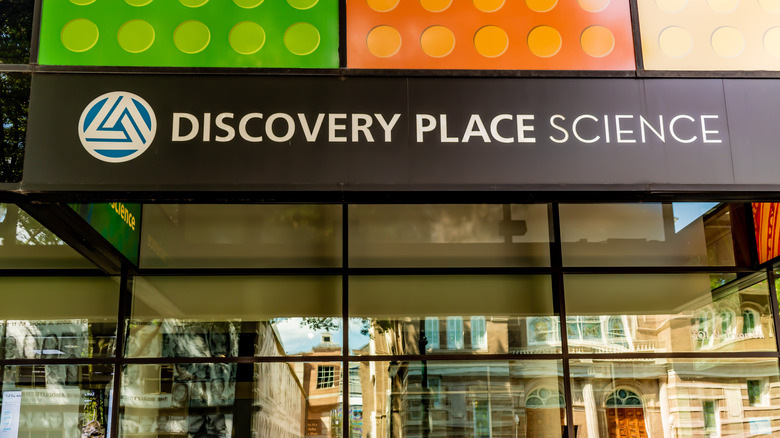America's Absolute Best Science Museums, According To Reviews
Science absolutely fascinates kids. Who could forget all those chemistry kits we received as gifts when we were youngsters? The excitement of discovering how chemicals react or how forces relate is just a couple of the many eye-opening things science teaches us when we're young. And, of course, nowadays, science can also bring families together for fantastic days out. With our school days not long enough to cover every scientific experiment and discovery — or perhaps, because time has faded the memory of knowledge — science museums serve as an excellent way for kids to learn (and their parents and grandparents to join in and learn all over again).
From one coast to the other, the U.S. has a large number of world-class and diverse science museums. It doesn't matter if you're a visitor to the country or you've lived next door to one of these fantastic institutes all your life; taking in a science museum is a fun family day out. From L.A. to Florida, you have a variety of different museums offering education in various scientific fields, from paleontology to physics. Here are the absolute best science museums the country has to offer.
National Museum of Nuclear Science & History, Albuquerque, New Mexico
While Albuquerque may be a cool destination for filming movies and TV shows, it also has a plethora of tourist attractions. Among them is the National Museum of Nuclear Science & History. It has been located in the city since 2009 and is a Smithsonian Affiliate and accredited by the American Alliance of Museums. It was established to tell the story of the Atomic Age, from the beginnings of nuclear arms development to the peaceful use of atomic technology. With a mission statement proclaiming the museum wishes "to serve as America's resource for nuclear history and science," the museum strives to educate on the people and events that have historically shaped this particular field.
With extensive exhibits covering atomic theory, World War II and the subsequent Cold War, nuclear medicine, and the future of nuclear science, visitors can get an objective view of the multifaceted nature of the atomic age. The displays are creative, and the museum is well organized, with visitors appreciating the combination of history and science. One satisfied guest was particularly impressed with the museum's historical accounts, saying, "[I] love the Oppenheimer exhibit! ... there's a volunteer that had real-world experience with the making of the atomic bomb."
Museum of Science and Industry, Chicago, Illinois
In operation since 1933, the Museum of Science and Industry is definitely not one of the tourist traps in Chicago that you should avoid. This museum is "dedicated to inspiring the inventive genius in everyone." It is the largest science museum located in the Western Hemisphere and one of the biggest in the entire world. The museum brings science to life through its interactive experiences and has something for all ages.
With exhibits and educational programs focused on science and industry, the museum covers technology, engineering, physics, and biology. The U-505 Submarine Exhibit is one of the most popular. It tells the gripping story of its capture by the U.S. Navy as well as educates visitors on the technology of U-boats. One TripAdvisor reviewer quipped, "The U-boat exhibit was my favorite part... you can walk inside an actual captured German sub from World War II." However, it's just one of many fascinating displays. The 007: Science Inventing the World of James Bond exhibit, for example, showcases how real-life science influenced many of the fantastical gadgets seen in movies. Visitors can even see prototypes from the films, such as Bond's jetpack from "Thunderball."
Museum of Science, Boston, Massachusetts
Boston is one of Rick Steeves' favorite cities in America, and it's no wonder with attractions like the Museum of Science. It's one of the best places for visitors to increase their knowledge while having truckloads of fun. Exhibits and educational programs span various scientific fields, including physics, engineering, biology, and astronomy. In addition, visitors can enrich their knowledge with immersive shows at the Mugar Omni Theater, the Charles Hayden Planetarium, and a 4-D Theater that offers a full-sensory experience.
Boston's Museum of Science is dedicated to the potential of every student. With programs for kindergarten to high school pupils, the museum strives to educate kids on modern science, technology, engineering, and math (STEM) skills. Exhibits range all the way from prehistoric eras to the modern age of artificial intelligence.
A 65-million-year-old Triceratops fossil named Cliff is one of the museum's most popular displays. At the same time, the Exploring AI: Making the Invisible Visible exhibit brings us into the future and showcases the use of AI in the fields of healthcare, transportation, commerce, and education. Visitors can interact with an AI-powered Mars Rover and a robotic dog from Boston Dynamics. It's enlightening and entertaining for the whole family, with one elderly reviewer commenting on Google, "Fun for the 72-year-old grandmother, 36-year-old parents, and three and 3/4 and 15-month-old children. Exhibits are engaging, interactive, and educational!"
California Science Center, Los Angeles
The California Science Center was renamed in 1998 from the California Museum of Science and Industry to reflect its standing as a public institution for the education of science. It has been a Smithsonian Affiliate since 2000, and the museum covers a wide range of scientific fields, including space exploration, biology, and technology. The center's mission statement is "to stimulate curiosity and inspire science learning in everyone by creating engaging and memorable experiences." And according to online reviews, it does this and then some.
Permanent galleries range from Ecosystems, where you'll find more than 200 species in 11 ecological zones, to Air and Space, where you can learn all about traveling the skies and beyond. Visitors have raved about the interactive exhibits, while the IMAX theater offers a variety of 3D movies, including "Cities of the Future" and "Blue Whales." However, the most popular exhibit, the Space Shuttle Endeavour is offline until its new home, the Samuel Oschin Air and Space Center, is complete. But visitors can still get a sneak peek at some of the planned new exhibits, such as the SpaceX Dragon and Rocket Lab Electron, at the Work in Progress Gallery.
Denver Museum of Nature & Science, Colorado
Denver attracts all kinds of tourists, from those seeking awe-inspiring hikes to fun-filled family days out. The Denver Museum of Nature & Science comes under the latter category. It bills itself as a natural history and science museum and offers budding scientists an education in fields as diverse as paleontology and astronomy. Tracing its origins all the way back to 1868, the museum has undergone several transformations. However, it wasn't until the year 2000 that it settled on its current name. The museum boasts over 4.3 million artifacts, as well as significant scientific contributions, including a large-scale excavation known as the Snowmasstodon Project. This excavation famously unearthed thousands of Ice Age fossils, including mammoths and giant ground sloths.
The institute "envisions an empowered community that loves, understands, and protects the natural world." It houses many popular exhibits, including The Power of Poison, which explores the different uses of poison in nature, including survival, defense, and healing. Another, the Corral Bluffs Fossil Discovery, showcases one more recently discovered treasure trove of fossils. It features relics that allow visitors to find out how Earth recovered after the asteroid impact that wiped out the dinosaurs. In fact, dinosaur lovers can marvel at the remains of these ancient reptiles all around the museum, with one TripAdvisor reviewer exclaiming, "Kids who are into dinosaurs are likely to have a wonderful time as huge, life-sized skeletons are absolutely everywhere in the museum!"
U.S. Space & Rocket Center, Huntsville, Alabama
The U.S. Space & Rocket Center (USSRC) in Huntsville opened its doors in 1970 with the purpose of displaying hardware from the country's space program. This includes a full-scale, restored model of the Saturn V, recognized as the biggest and most powerful rocket ever built, the Pathfinder, the world's only full-stack space shuttle display, and the Apollo 16 command module. One of the more moving displays details the Apollo missions, with one Google reviewer exclaiming, "to be able to experience all the creativity, planning, and sacrifice that went into getting a man on the moon during the Apollo V mission... [it's] definitely worth a visit." Visitors can also enjoy the Intuitive Planetarium for immersive cosmic shows and interactive simulators that replicate astronaut training.
The museum is a Smithsonian Affiliate that offers camps and educational programs catering to a variety of age groups. Space Camp, for example, has been an inspiration since 1982. It's renowned around the world as an excellent program for developing teamwork and leadership skills and is another that is based on NASA's astronaut training. With these educational programs and fascinating exhibits, the USSRC aims to educate and inspire future generations about space exploration and STEM fields.
Exploratorium, San Francisco, California
San Francisco may have the tag of America's least-stressed city, but the Exploratorium is a fun-filled and exciting day out for anyone. It's billed as a museum of science, technology, and arts, and places an emphasis on interactive exhibits and hands-on learning. It first opened in 1969 and was founded by Frank Oppenheimer (that Oppenheimer's younger brother), a former experimental physicist, professor, and high school teacher. His goal was to create a museum where visitors could explore science at their own pace. This vision has very much been realized with the museum's wide variety of interactive displays and educational programs that continue to inspire curiosity and stimulate ideas.
With over 700 interactive displays, visitors can explore scientific concepts in a hands-on way. Among the more popular are the Tornado Exhibit and Tactile Dome. The former is an indoor simulation of a tornado that involves fans and fog machines to form vortexes. The Tactile Dome is an entirely different experience. Here, visitors climb, crawl, grab, slide, and feel their way through "a wonderland of textures" in complete and utter darkness.
Additionally, those looking to go on an exciting date or just have some "me time" with a bit of a difference can join the After Dark weekly event every Thursday night. Kids are not allowed, and it's a great opportunity for adults to explore their inner child and engage in fascinating displays while enjoying a drink in a unique environment.
McWane Science Center, Birmingham, Alabama
The McWane Science Center in Birmingham, Alabama, has a fairly short history. It has been welcoming guests since 1998, but it is a state-of-the-art museum and one that reviewers found to be family-friendly and interactive. It features exhibits and programs focused on scientific fields as diverse as biology, physics, and technology and stands out as one of the best in the country.
Striving to inspire its community through STEM, the McWane Science Center offers hands-on activities and inquiry-based learning as opposed to dull, old lectures. Exhibits are engaging, and the first floor features a wide array of interactive exhibits, from anti-gravity mirrors to the Distortion Room, where visitors can explore visual perception and optical illusions. The museum also houses an excellent aquarium with shark and stingray touch tanks, animal shows, and a dinosaur excavation area in the Alabama Dinosaurs exhibit.
Additionally, visitors have a lot of praise for the museum's IMAX Dome Theater, which uses laser technology with a five-story tilted dome screen to deliver incredibly lifelike images and sound. Documentaries are fun and educational, with one satisfied customer taking the time to say on TripAdvisor, "Went to an IMAX documentary showing 'Ancient Caves.' [The] experience was awesome, unlike any other cinematic experience."
California Academy of Sciences, San Francisco
Located in San Francisco's picturesque Golden Gate Park, the California Academy of Sciences strives "to repair our damaged ecosystems and climate." Furthermore, it aims to do so through science, learning, and collaboration. The museum is all about the ecosystems of our planet, including reefs and rainforests. With one of the most biologically diverse and interactive aquariums in the world, the institute is renowned globally for its advanced oceanic research. The stunning displays include a Philippine Coral reef section in the basement. Here, visitors can enjoy stunning colors and over 1,000 unique species. Among them is a 92-year-old Australian lungfish, which is recognized as the oldest living aquarium fish in the world.
Other popular exhibits include the Osher Rainforest section, which is housed in a 90-foot diameter glass dome. It's the biggest on the planet, with a four-story rainforest and a collection of over 1,600 plants and animals, from free-flying birds and colorful butterflies to exotic reptiles. One Google reviewer was so impressed that they felt compelled to write, "I felt much joy seeing the beautiful butterflies hovering over me. This made me desirous of constructing my dream butterfly garden."
The Franklin Institute, Philadelphia, Pennsylvania
Philadelphia is thought of as one of America's most underrated cities. And with attractions like the Franklin Institute, it's no wonder. It's yet another top-tier American science museum and one that will appeal primarily to kids under the age of 14 (according to reviewers). That's not to say anyone over this age will not enjoy it. But with human anatomy walk-through exhibits and an interactive display featuring intricate Lego constructions, it's definitely one for youngsters to get excited about. One reviewer on TripAdvisor enthusiastically commented on the Art of the Brick exhibit, describing it as "the perfect combination of art and engineering."
In the Your Brain exhibit, kids can enjoy climbing structures while learning all about the organ's incredible functions through playful activities. Similarly, the walk-through heart exhibit allows children to learn about their anatomy in a more immersive manner than anywhere else. Kids also enjoy the live science demonstrations on liquid nitrogen and the Tesla coil. The content is highly educational, yet it's delivered in an engaging and fun way. One TripAdvisor reviewer was impressed to the point that they had to mention, "The highlight was actually the show with the liquid nitrogen- the guy was funny and had my kid laughing through the whole show- and the show was informative."
Other excellent exhibits include Wonderous Space, a new two-story display that promises an "immersive and awe-inspiring journey through the marvels of space exploration!" If that's not enough, there's a well-received planetarium, a Sports Zone display, and a Science Park, among many other exhibits.
Orlando Science Center, Florida
Orlando isn't only about world-class water parks. There are plenty of other family-friendly attractions, including the Orlando Science Center. It's a hands-on museum that has been bringing science to life since 1955 and has been wowing an average of 670,000 annual visitors at its current location since 1993. The center aims to be "a place for our community to gather and celebrate science, technology, engineering, and math (STEM)." While many reviewers claim it is mainly for younger kids, some mentioned it is a good day out for older kids, too. One proud grandparent proclaimed, "Great for families! Lots of hands-on activities for kids, and the grandkids had a blast!" while another parent commented, "An amazing day! I took my two boys, ages 9 and 14, and we spent hours having fun with hands-on exhibits."
Exhibits are diverse in their range of scientific genres. The Kinetic Zone focuses on physics with a range of interactive exhibits, from air rockets to electric circuits. One satisfied parent on TripAdvisor shared, "The Kinetic Zone was pure excitement. It's all about motion and physics, and my kids couldn't get enough of trying every experiment they could get their hands on!"
The newer Life display focuses on nature and conservation and is the center's largest and most complex exhibit ever. It features three distinct environments: Rainforest, Ocean, and Swamp, where guests can get close to the animals of each ecosystem. You can also try your hand at smashing world records at The Science of Guinness World Records exhibit or explore the world of dinosaurs at DinoDigs.
Discovery Place Science, Charlotte, North Carolina
Discovery Place Science in Charlotte, North Carolina, is a premier science museum "dedicated to inspiring curiosity and fostering a lifelong love of learning." It's suitable for the whole family, from toddlers to grandma and grandpa. One Google reviewer said, "Everyone in our group (ages 5-65) had a great time and learned cool stuff about nature, animals, the human body, and space. This is not a boring museum; everything is hands-on and creative."
The institute offers labs, live shows, and educational programs on scientific subjects, including physics, chemistry, biology, and environmental science. One of the more popular attractions is the Fantastic Frogs exhibit. Here, families can learn about the evolutions and unique adaptations of various species to their environments. In addition to experiencing these unique frogs from around the world in the flesh, visitors also get to learn all about them through interactive games and fascinating scientific movies.
You can discover the biodiversity of our planet at the World Alive Rainforest exhibit. Here, you will find a variety of ecosystems, including an actual rainforest that is home to exotic birds, reptiles, and other animals. There's a canopy rope bridge to get a bird's-eye view and even an aquarium with a real coral reef where you can marvel at a stunning collection of tropical fish and other marine animals, including stingrays and giant clams.
Methodology
With so many fantastic science museums in the U.S., choosing just a few was a difficult task. However, we decided to rely on Google and TripAdvisor reviews to get the most opinions. We only selected institutes that received overall scores of 4.5 or higher on both sites and had a minimum of 1,000 reviews for transparency.

